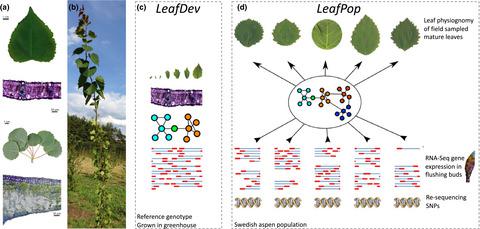当前位置:
X-MOL 学术
›
Ecol. Evol.
›
论文详情
Our official English website, www.x-mol.net, welcomes your
feedback! (Note: you will need to create a separate account there.)
Leaf shape in Populus tremula is a complex, omnigenic trait
Ecology and Evolution ( IF 2.3 ) Pub Date : 2020-10-13 , DOI: 10.1002/ece3.6691 Niklas Mähler 1 , Bastian Schiffthaler 1 , Kathryn M Robinson 1 , Barbara K Terebieniec 1 , Matej Vučak 2 , Chanaka Mannapperuma 1 , Mark E S Bailey 2 , Stefan Jansson 1 , Torgeir R Hvidsten 3 , Nathaniel R Street 1
Ecology and Evolution ( IF 2.3 ) Pub Date : 2020-10-13 , DOI: 10.1002/ece3.6691 Niklas Mähler 1 , Bastian Schiffthaler 1 , Kathryn M Robinson 1 , Barbara K Terebieniec 1 , Matej Vučak 2 , Chanaka Mannapperuma 1 , Mark E S Bailey 2 , Stefan Jansson 1 , Torgeir R Hvidsten 3 , Nathaniel R Street 1
Affiliation

|
Leaf shape is a defining feature of how we recognize and classify plant species. Although there is extensive variation in leaf shape within many species, few studies have disentangled the underlying genetic architecture. We characterized the genetic architecture of leaf shape variation in Eurasian aspen (Populus tremula L.) by performing genome‐wide association study (GWAS) for physiognomy traits. To ascertain the roles of identified GWAS candidate genes within the leaf development transcriptional program, we generated RNA‐Seq data that we used to perform gene co‐expression network analyses from a developmental series, which is publicly available within the PlantGenIE resource. We additionally used existing gene expression measurements across the population to analyze GWAS candidate genes in the context of a population‐wide co‐expression network and to identify genes that were differentially expressed between groups of individuals with contrasting leaf shapes. These data were integrated with expression GWAS (eQTL) results to define a set of candidate genes associated with leaf shape variation. Our results identified no clear adaptive link to leaf shape variation and indicate that leaf shape traits are genetically complex, likely determined by numerous small‐effect variations in gene expression. Genes associated with shape variation were peripheral within the population‐wide co‐expression network, were not highly connected within the leaf development co‐expression network, and exhibited signatures of relaxed selection. As such, our results are consistent with the omnigenic model.
中文翻译:

欧洲山杨的叶子形状是一个复杂的全基因性状
叶子形状是我们识别和分类植物物种的一个决定性特征。尽管许多物种的叶子形状存在广泛差异,但很少有研究能够解开潜在的遗传结构。我们通过对相貌性状进行全基因组关联研究(GWAS)来表征欧亚白杨( Populus tremula L.)叶子形状变异的遗传结构。为了确定已识别的 GWAS 候选基因在叶发育转录程序中的作用,我们生成了 RNA-Seq 数据,用于对发育系列进行基因共表达网络分析,该数据在 PlantGenIE 资源中公开可用。我们还使用整个群体中现有的基因表达测量来分析全群体共表达网络背景下的 GWAS 候选基因,并识别具有对比叶子形状的个体组之间差异表达的基因。这些数据与表达 GWAS (eQTL) 结果相结合,定义了一组与叶形变异相关的候选基因。我们的结果发现,与叶子形状变异没有明显的适应性联系,并表明叶子形状特征在遗传上是复杂的,可能是由基因表达中的许多小效应变化决定的。与形状变异相关的基因在群体共表达网络中处于外围,在叶子发育共表达网络中没有高度连接,并表现出宽松选择的特征。因此,我们的结果与全基因模型一致。
更新日期:2020-11-13
中文翻译:

欧洲山杨的叶子形状是一个复杂的全基因性状
叶子形状是我们识别和分类植物物种的一个决定性特征。尽管许多物种的叶子形状存在广泛差异,但很少有研究能够解开潜在的遗传结构。我们通过对相貌性状进行全基因组关联研究(GWAS)来表征欧亚白杨( Populus tremula L.)叶子形状变异的遗传结构。为了确定已识别的 GWAS 候选基因在叶发育转录程序中的作用,我们生成了 RNA-Seq 数据,用于对发育系列进行基因共表达网络分析,该数据在 PlantGenIE 资源中公开可用。我们还使用整个群体中现有的基因表达测量来分析全群体共表达网络背景下的 GWAS 候选基因,并识别具有对比叶子形状的个体组之间差异表达的基因。这些数据与表达 GWAS (eQTL) 结果相结合,定义了一组与叶形变异相关的候选基因。我们的结果发现,与叶子形状变异没有明显的适应性联系,并表明叶子形状特征在遗传上是复杂的,可能是由基因表达中的许多小效应变化决定的。与形状变异相关的基因在群体共表达网络中处于外围,在叶子发育共表达网络中没有高度连接,并表现出宽松选择的特征。因此,我们的结果与全基因模型一致。











































 京公网安备 11010802027423号
京公网安备 11010802027423号